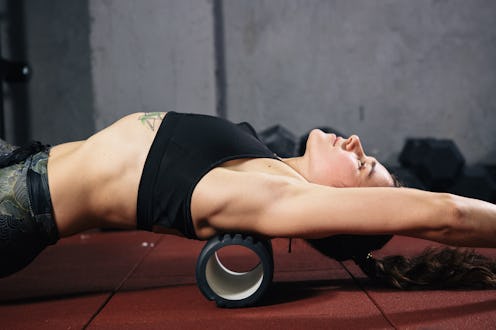Life
Foam Rolling Is Actually Good For You — If You’re Breathing Into It Right

Lots of people are stoked about foam rolling these days. Foam rolling devotees report benefits like more flexibility, increased range of motion, better blood circulation, injury prevention, and improved muscle recovery. Foam rolling works by massaging the myofascia, aka the areas where the body’s connective tissue and muscles meet, relieving tense muscles and improving blood and nutrient flow throughout the body. Foam rolling, which involves rolling different body parts over a foam tube, supposedly offers an inexpensive way to self-administer a simple myofascial release technique, so you can reap all the benefits at home with an inexpensive piece of equipment. But while it sounds amazing, many people want to know if foam rolling is *actually* good for you.
Buzzy fitness trends come and go, and those with staying power are those that offer solid benefits that stand the test of time. According to TIME, there is some research that supports the reported benefits of foam rolling. In a study published in the Journal of Sports Rehabilitation, researchers found that foam rolling, when combined with traditional stretching techniques, was more effective at releasing and relaxing the hip muscles than stretching alone.
"Foam rolling has many benefits including reducing tension in the muscles and body, aiding in muscle recovery and blood flow, and [helping with] injury prevention," Dr. Armin Tehrany, founder of Manhattan Orthopedic Care, tells Bustle via email. Dr. Tehrany further explains that foam rolling distributes force via body weight across the body's soft-tissue layers. This helps release the tissue and lengthen the muscles — all of which promotes better overall mobility.
If you decide to give foam rolling a whirl, Dr. Tehrany suggests daily rolling anywhere from five to 20 minutes, pre- and post-workout. "Roll slowly, and make sure to keep breathing so that your muscles can relax as much as possible throughout the process," Dr. Tehrany says. Further, Dr. Tehrany suggests that using a foam roller pre-workout can help reduce tension and increase blood flow, while post-workout rolling helps speed up muscle recovery.
The Independent notes that while foam rollers might be the latest must-have gym toy, they were previously used for professional athletes only. Moshe Feldenkrais, the Israeli physicist and engineer who pioneered the Feldenkrais Method of movement therapy, started using the rollers as part of his technique to improve physical performance in athletes. The Independent further notes that U.S. sports therapist Michael Clark introduced the tubes into the mainstream fitness realm with his 2001 book, Integrated Training for the New Millennium, and they’ve exploded in popularity ever since.
Runner’s World also suggests that many coaches consistently recommend foam rolling techniques as a way to reduce soreness and amp up recovery and performance. And a study in Medicine & Science in Sports & Exercise offers some evidence that foam rolling after intense exercise can relieve soreness over the course of the following few days. Runner’s World further notes that foam rolling, like massage, stimulates the nervous system to help relax and release tense muscles.
Plenty of doctors, coaches, and physical therapists suggest that using the tubes seems to provide benefits for lots of folks. And while researchers are still in the process of confirming the ultimate benefits of the practice, there’s little harm in trying the technique for yourself if it's applied correctly. And if you experience increased flexibility and increased range of motion — not to mention that any type of massage technique just feels pretty great — all the better.